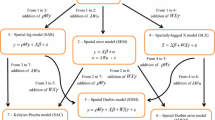Abstract
We study how different prior assumptions on the spatially structured heterogeneity term of the convolution hierarchical Bayesian model for spatial disease data could affect the results of an ecological analysis when response and exposure exhibit a strong spatial pattern. We show that in this case the estimate of the regression parameter could be strongly biased, both by analyzing the association between lung cancer mortality and education level on a real dataset and by a simulation experiment. The analysis is based on a hierarchical Bayesian model with a time dependent covariate in which we allow for a latency period between exposure and mortality, with time and space random terms and misaligned exposure-disease data.
Similar content being viewed by others
References
Besag J (1974) Spatial interaction and the statistical analysis of lattice systems (with discussion). J R Stat Soc B 36: 192–236
Besag J, York JC, Mollié A (1991) Bayesian image restoration, with two applications in spatial statistics (with discussion). Ann Inst Stat Math 43: 1–59
Best N, Richardson S, Thomson A (2005) A comparison of Bayesian spatial models for disease mapping. Stat Meth Med Res 14: 35–59
Breslow NE, Clayton DG (1993) Approximate inference in generalized linear mixed models. J Am Stat Assoc 88: 9–25
Catelan D, Biggeri A, Dreassi E, Lagazio C (2006) Space-cohort Bayesian models in ecological studies. Stat Model 6: 159–173
Clayton DJ (1996) Generalized linear mixed models. In: Gilks WR, Richardson S, Spiegelhalter DJ (eds) Markov Chain Monte Carlo in practice. Chapman and Hall, London, pp 275–301
Clayton DJ, Bernardinelli L, Montomoli C (1993) Spatial Correlation in Ecological Analysis. Int J Epidemiol 22: 1193–1202
Clayton DG, Kaldor J (1987) Empirical Bayes estimates of age-standardized relative risks for use in disease mapping. Biometrics 43: 671–681
Cressie NA (1993) Statistics for Spatial Data. Wiley, New York
Diggle PJ, Tawn JA, Moyeed RA (1998) Model-based geostatistics. Appl Stat 47: 299–350
Dreassi E, Biggeri A, Catelan D (2005) Space-time models with time dependent covariates for the analysis of the temporal lag between socio-economic factors and lung cancer mortality. Stat Med 24: 1919–1932
Green PJ, Richardson S (2002) Hidden Markov models and disease mapping. J Am Stat Assoc 97: 1–16
Kelsall J, Wakefield J (2002) Modeling spatial variation in disease risk: a geostatistical approach. J Am Stat Assoc 97: 692–701
Knorr-Held L (2000) Bayesian modelling of inseparable space-time variation in disease risk. Stat Med 17–18: 2555–2568
Laud P, Ibrahim J (1995) Predictive Model Selection. J R Stat Soc B 57: 247–262
Spiegelhalter DJ, Thomas A, Best NG, Gilks WR (2000) WinBugs. Medical Research Council Biostatistics Unit, Cambridge
Stern HS, Cressie NA (1999) Inference for extreme in disease mapping. In: Lawson A, Biggeri A, Bohning D, Lesaffre E, Viel JF, Bertolini R (eds) Disease mapping and risk assessment for public health. Wiley, Chichester, pp 63–84
Sun D, Tsutakawa RK, Kim H, He Z (2000) Spatio temporal interaction with disease mapping. Stat Med 19: 2015–2035
Tanner MA, Wong WH (1987) The calculation of posterior distributions by data augmentation. J Am Stat Assoc 82: 528–540
Vigotti MA, Biggeri A, Dreassi E, Protti MA, Cislaghi C (2001) Atlas of mortality in Tuscany 1971–94. Edizioni Plus, Università degli studi di Pisa
Wakefield J (2003) Sensitivity Analysis for Ecological Regression. Biometrics 59: 9–17
Waller LA, Carlin BP, Hong X, Gelfand AE (1997) Hierarchical spatio-temporal mapping of disease rates. J Am Stat Assoc 92: 607–617
Author information
Authors and Affiliations
Corresponding author
Rights and permissions
About this article
Cite this article
Catelan, D., Biggeri, A. & Lagazio, C. On the clustering term in ecological analysis: how do different prior specifications affect results?. Stat Methods Appl 18, 49–61 (2009). https://doi.org/10.1007/s10260-007-0089-x
Accepted:
Published:
Issue Date:
DOI: https://doi.org/10.1007/s10260-007-0089-x




